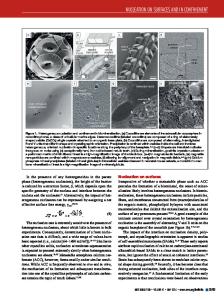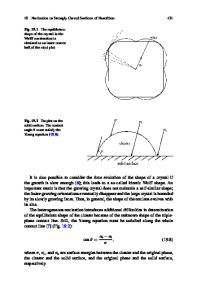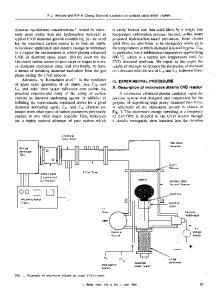Nucleation, growth, and aggregation of gold on polyimide surfaces
- PDF / 715,307 Bytes
- 11 Pages / 612 x 792 pts (letter) Page_size
- 46 Downloads / 329 Views
MATERIALS RESEARCH
Welcome
Comments
Help
Nucleation, growth, and aggregation of gold on polyimide surfaces Y. Travaly, L. Zhang, Y. Zhao, R. Pfeffer, K. Uhrich, F. Cosandey, E. Garfunkel,a),b) and T.E. Madeya),c) Laboratory for Surface Modification, Rutgers—The State University of New Jersey, Piscataway, New Jersey 08854 (Received 23 November 1998; accepted 7 June 1999)
The growth of ultrathin gold films on polyimide (PI) surfaces and the stability of the films upon thermal annealing have been studied using a combination of various techniques. With scanning electron microscopy (SEM) we observe that, at room temperature, the Au film initially grows by nucleation of compact Au islands. With increasing metal coverage, the clusters partially agglomerate to produce a wormlike structure. Finally, percolation, hole-filling, and continuous thin-film growth are observed. To evaluate the thermal stability of the Au/PI system, annealing at various temperatures was performed on films that displayed the wormlike structure. SEM results indicate strong temperature-dependent changes in film morphology. Finally, from our SEM data we determine contact angles, allowing us to estimate interfacial and adhesion energies.
I. INTRODUCTION
The metal/polymer interface plays a key role in a variety of existing and emerging issues in the microelectronics, optoelectronics, corrosion, and tribology industries. For example, in microelectronics two areas where metal/polymer interfaces may become critical are in packaging and interconnect dielectrics. The continuous down-scaling of interconnect geometries will result in a drastic relative increase in propagation delay and power dissipation due to resistance-capacitance (RC) coupling.1 In order to overcome the RC coupling problem, new materials of lower permittivity than SiO2 (low- materials) are needed2 if industry is to meet the high switching-speed requirements. Because a primary concern in technological applications is the reliability of the device, a better understanding of the metal/polymer interaction together with the role the metal and polymer play in device contamination are needed. Further, the new dielectric materials must be consistent with processing temperatures and thermal conductivity requirements for heat transfer, both key issues that must be resolved before polymers are incorporated in future interconnect or other structures. A detailed understanding of the polymer and polymer/metal interface properties is mandatory not only here but in most applications. a)
Address all correspondence to these authors. e-mail: [email protected] c) e-mail: [email protected] b)
J. Mater. Res., Vol. 14, No. 9, Sep 1999
http://journals.cambridge.org
Downloaded: 16 Feb 2015
During the last few years, much work has been accomplished in this field using various microscopic and surface-sensitive techniques. These studies were aimed at understanding the nature of the interaction between polyimide (PI) substrates and a variety of metals.4–8 Results of x-ray photoelectron studie
Data Loading...










